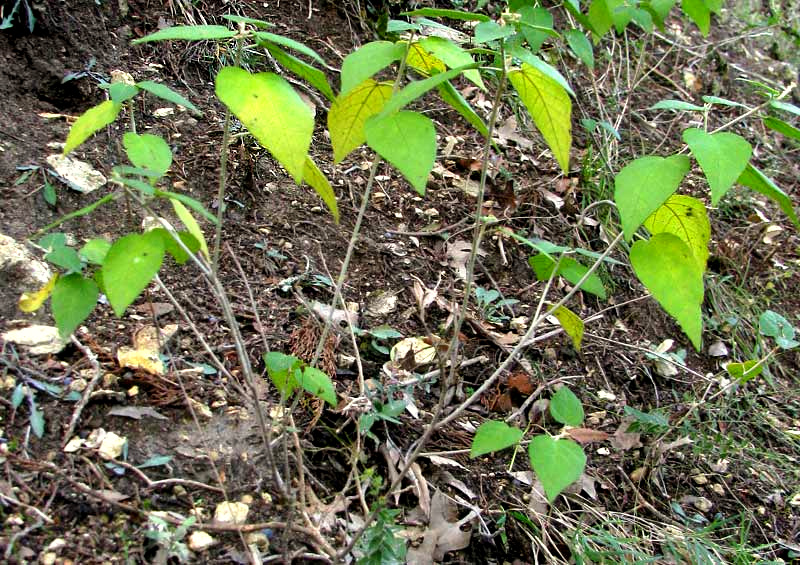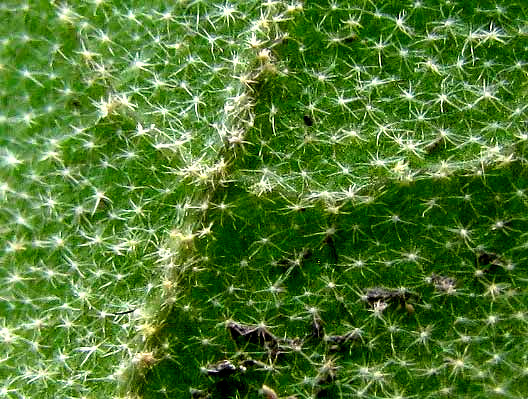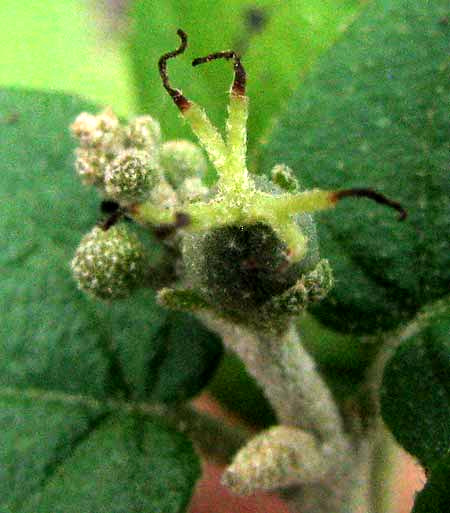Excerpts from Jim Conrad's
Naturalist Newsletter

from the December 8, 2013 Newsletter issued from the Frio Canyon Nature Education Center in the valley of the Dry Frio River in northern Uvalde County, southwestern Texas, on the southern border of the Edwards Plateau; elevation ~1750m (~5750 ft); N29.62°, W99.86°; USA
BUSH CROTON
On our hill's steep, deeply shaded eastern slope a knee-high bush with fairly large, heart shaped leaves turning yellow and about to be shed caught my eye. You can see its several slender, branching, soft-woody stems above.
Back East I might have overlooked the plant, thinking it was a runty Wild Hydrangea, but none of North America's five wild hydrangea species extend as far west as Texas, so this was something else. When I began looking closely, the first unusual field mark to be noticed was that the herbage -- which was strongly spicy-smelling -- was densely covered with stiff, spiky, whitish hairs. Moreover, the hairs were of the special kind known as "stellate," or star-shaped hairs -- with several sharp spines radiating from a common base. Below, you can see this plant's stellate hairs on the undersurface of a leaf:

Next I noticed that several branches were tipped with small clusters of unisexual flowers. A female flower's ovary topped with three deeply split styles, with a resulting six blackish stigmas, is shown below:

I had thought the stigmas might be blackened by recent freezes, but other pictures of the species on the Internet also show black stigmas, so this must be a regular feature.
Lately we've seen several plants with fruits, styles and stigmas like this, all in the Euphorbia or Poinsettia Family, the Euphorbiaceae, so now we know the plant's family. Moreover, within the Euphorbia Family there's a big genus whose herbage is mantled with stellate hairs just like those in our picture, and that genus is Croton. You might remember that back in August a common weed called Prairie Tea, Croton Monanthogynus, abundantly grew around Juniper House. You might enjoy comparing our present plant's fruits and stellate hairs with that species', at http://www.backyardnature.net/n/h/croton.htm.
This second Croton species isn't weedy at all, but rather a retiring species favoring limestone hills, bluffs, canyons and rocky ravines at altitudes of 1,000-4,500 feet, in central and western Texas, southern New Mexico and Arizona, and adjacent arid northern Mexico. Often it's called Bush Croton. It's CROTON FRUTICULOSUS.
Informed gardeners regard this as a good shrub for shady spots, not only because it produces attractive leaves that turn yellow in the fall, but because the herbage is highly deer resistant.
Delena Tull in Edible and Useful Plants of Texas and the Southwest: A Practical Guide reports that leaves of Bush Croton can be used to make tea, but warns that other similar-looking Croton species are skin irritants and toxic, so one should be careful.